- A new smile
- Esthetics and functionality
- Impossible? A word not existing in our library...
- An uncompromised smile
A new smile
Our patient came to us with moving teeth, that were beyond all professional possibilities to stabilize and save due to progressive end stage paradontal disease and bone loss. Due to her social status she really wanted to have a beautiful smile provided by fixed bridges, instead of removable dentures. Most unfortunately we really had to remove her teeth as her status was obvious looking at her original OPG. Thus she really become edentulous (without any teeth) when we embarked to reconstruct her smile.
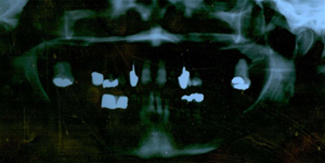
Before implantation procedure
Our oral surgeon performed bone augmentation (Onlay and sinus lifts) with 9 implants into her upper jaw and 5 implants were placed into the mandible. Following the implant placement and healing we took the impressions, checked the metal basis and finally we fixed the new bridges.
Great care was taken, that the new crowns should provide the high demand esthetics with their natural forms and sizes, which taken into account the high degree original bone loss, was enhanced by using pink/ gum colored ceramics to keep the length of the crowns within the demands of the final esthetics.
X-ray views of the osteointegrated implants, the screws fixing the bone blocks are also visible.
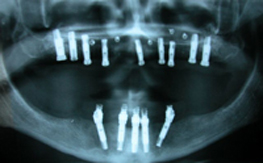
Lower and upper implants

With Branemark bridge

After dental implantation procedure
Esthetics and functionality
Our 51 year old patient arrived to us with missing teeth, old fillings and crowns, extremely worn teeth (abrasion). He needed full mouth rehabilitation. Thus unfortunately we needed to prepare all his teeth.
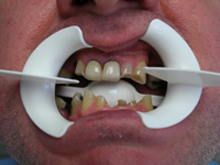
Before treatment
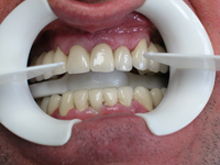
Upper and lower bridge
The process of dental treatment
The treatment was basically divided between the upper and lower jaw. We started with the upper. As he had anterior cross-bite, we had to make root canal fillings. Then the patient received a full upper bridgework, to set the right bite, the right facial height and also to train the temporomandibular joint for bite raising purposes.
He had dental implants in the region his missing lower molar regions. Following the osteointegration of these implants we could prepare the lower fixed porcelain bridgework.
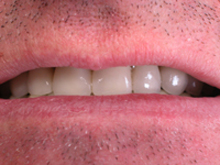
After dental treatment
Our patient was perfectly happy with the result as it was not only esthetically pleasing, but also his bite was functionally restored.
Impossible? A word not existing in our library...
This patient of ours was delaying definitive reconstructing works on his teeth for decades, for the reason of fear. He was afraid of a long serious of painful and long dental procedures when the whole would start. Nevertheless after a long time eventually convinced by his wife, he embarked on the treatment. Despite his age being worried as a child he finally forced himself into our dental chair. Fortunately following a long consultation when he got answers to all his questions his fears grossly reduced and eventually started the treatment with full confidence.
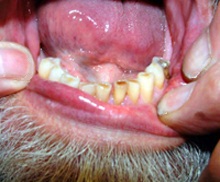
Before first implantation treatment
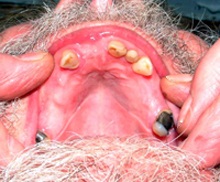
Before second implantation treatment
Fortunately in this gentleman’s medical history there was nothing serious noted that could contraindicate our dental and surgical plans. He had only vague history of allergic reactions to penicillin in the past.
As you can see our patient arrived with eight missing teeth in the upper jaw and we also had to remove one additional tooth.
As a next step we performed bilateral (both side) sinus lifts (bone augmentation to the sinuses e.g. between the bony floor of the maxillary sinus and the elevated sinus membrane) together with placing 7 implants into the upper jaw. As he was missing his molars and premolars in his bottom jaw with no tooth in the far end (free and no possibility to prepare a conventional bridgework) we implanted 2-2 Camlog implants to both sides to reconstruct the basis for posterior molar support.
We also had to remove the mobile lower left central incisor (31) which had major paradontal disease.
The patient got a long term temporary bridge for the lower jaw and a temporary removable prosthesis for his upper jaw for the healing period. In 6 moths time we met again when the final, definitive dental work started.
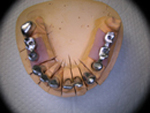
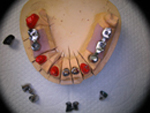

As a general good state of his upper right 7 (17) lower left 3, 4, 5 (3,4,5) and lower right 3, 4,5 (43, 44, 45) they did not need any dental work.
We have chosen the shape and color of the crowns according to the patients age and remaining teeth for a more natural look.
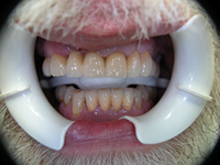
After implantation
An uncompromised smile
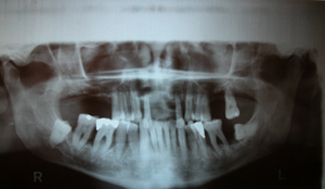
X-Ray before treatment
You can see on the orthopantomographic X-ray (short OPG) the end stage paradontitis, with major bone resorption around the existing teeth, which in turn make all teeth instable, mobile, impossible to function well in chewing, biting, not to mention esthetics and pains. (Bone level is approximately at the tip end of the roots)
Our patient had this X-ray (above) when he first arrived to us for a consultation. A through look on the OPG makes it clear that it is impossible to reduce inflammation, stabilize or save any teeth.
Unfortunately we had to remove all remaining teeth to fight against infection and further bone loss. 3 months following extractions the patient had simultaneous bilateral (left an right sided) sinus lifts together with the placing of the implants. 10 implants were inserted into the maxilla and 8 to the bottom jaw the mandible.
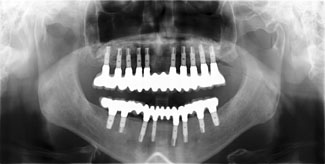
X-Ray after dental implantation process
For the healing periods the patient was wearing removable dentures.
Following the osteointegration – the healing of the implants started definitive dental rehabilitation. We constructed the upper and lower bridges to stabilize not only the occlusion but also the original facial height and of course to provide the best possible esthetics. Bearing in mind the considerable amount of lost bone height due to the original paradontal disease, to avoid the excessive crown length we kept the esthetic crown length and used pink/gum colored porcelain above the crowns for the best possible esthetics.
The final result is, as you can see, the uncompromised smile…
Implant supported crowns, stable function, chewing, natural smile, self confidence.
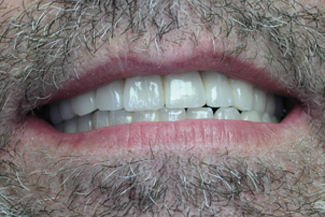
After dental implantation
 Français
Français  Русский
Русский  English
English 



